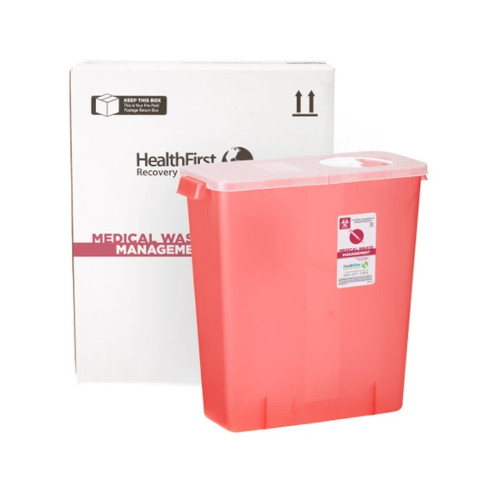Navigating Security: The Crucial Overview to Medical Waste Disposal Best Practices
Navigating Security: The Crucial Overview to Medical Waste Disposal Best Practices
Blog Article
Exploring Different Waste Disposal Options for a Cleaner Environment
In the quest of a cleaner setting, the administration of waste disposal has actually arised as a vital focal factor for lasting development. With a wide variety of waste disposal alternatives readily available, ranging from conventional land fill techniques to cutting-edge waste-to-energy modern technologies, the option of exactly how we handle our waste has significant implications for our world's wellness.
Recycling Methods
Executing efficient reusing methods is critical in reducing waste and advertising sustainability in our setting. Reusing involves the procedure of transforming waste materials into reusable things to protect against unnecessary disposal.
One more vital recycling method is composting, which includes decaying natural waste like food scraps and backyard trimmings right into nutrient-rich soil. This process not just draws away natural waste from land fills but also generates a beneficial source for gardening and agriculture. Additionally, upcycling is an imaginative recycling method that includes transforming old or discarded materials right into products of better or worth. By including these numerous reusing techniques into our waste administration techniques, we can considerably lower our ecological impact and move in the direction of a more lasting future.

Composting Strategies
Effective waste monitoring techniques, such as recycling approaches, lead the way for a cleaner atmosphere, and now, shifting the focus to 'Composting Techniques', we check out sustainable means to break down organic waste for ecological benefit. medical waste removal service.
Composting is an all-natural procedure that transforms natural waste, like food scraps and yard trimmings, right into a nutrient-rich soil amendment. The secret to successful composting exists in producing the ideal balance of eco-friendly materials, such as vegetables and fruit scraps, and brown materials, like dried out leaves and branches. These products decompose with the help of microbes, damaging down the waste into valuable compost.
Standard yard composting entails layering organic materials in a bin or pile and consistently turning the combination to aerate it. By utilizing composting methods, we can reduce the quantity of waste sent out to landfills while producing a helpful item for enhancing soil and sustaining plant development.
Incineration Cons and pros
Incineration, as a waste disposal technique, provides both advantages and downsides that warrant careful consideration in the world of sustainable waste administration practices. On the positive side, incineration can substantially reduce the quantity of waste, lessening the demand for garbage dump space and possibly reducing greenhouse gas emissions.
Nonetheless, there are notable downsides to incineration. One major worry is the prospective launch of harmful toxins into the air, such as dioxins, hefty steels, and particle matter, which can have unfavorable impacts on human health and wellness and the setting. Additionally, the high initial financial investment and functional prices of incineration centers posture economic challenges, making it a less cost-effective alternative contrasted to other waste administration approaches. Cautious surveillance and policy are necessary to mitigate these adverse influences and maximize the advantages of incineration as component of a detailed waste monitoring technique.
Landfill Monitoring Approaches
Garbage dumps play a vital duty in waste administration and environmental preservation by supplying a containment system for the disposal of strong waste products. Efficient land fill management approaches are vital to mitigate ecological influences and make certain the long-term sustainability of these waste disposal websites. One vital approach appertains waste compaction to maximize the use of offered area within the garbage dump (click here). By condensing the waste, the quantity is lowered, enabling more waste to be fit with time.
Moreover, the application of day-to-day cover methods is important in reducing odors, preventing trash, and reducing the tourist attraction of pests. Treatment the disposed waste at the end of every day aids to consist of smells and protect against possible ecological contamination. In addition, the tracking of garbage dump gas emissions and leachate levels is important in making certain that ecological requirements are satisfied and that any type of possible dangers to surrounding ecosystems are minimized.

Waste-to-Energy Technologies
Among the cutting-edge approaches to lose administration involves harnessing Waste-to-Energy technologies to convert strong waste into functional power sources. Waste-to-Energy (WtE) technologies include a variety of procedures that intend to extract power from waste products through thermal, chemical, or biological means. This conversion procedure not only decreases the volume of waste that winds up in land fills yet likewise creates useful energy resources such as electrical energy, warm, or biofuels.
There are a number of techniques of Waste-to-Energy conversion, including gasification, pyrolysis, and incineration. Incineration entails burning waste at high temperatures to produce warm and look at here power. Gasification transforms waste into a syngas, which can be utilized for power generation or chemical production. Pyrolysis breaks down organic materials utilizing high temperatures in the absence of oxygen, creating bio-oil, gas, and char.
Applying Waste-to-Energy modern technologies can help alleviate ecological concerns connected with traditional garbage disposal techniques while all at once supplying a renewable resource source. However, careful factor to consider should be offered to discharges control and ensuring the sustainability of feedstock products for these technologies to be absolutely useful for a cleaner environment.

Conclusion
To conclude, checking out various garbage disposal alternatives such as reusing, composting, incineration, garbage dump monitoring, and waste-to-energy innovations is vital for advertising a cleaner atmosphere - click here. Each technique has its very own benefits and challenges, yet by utilizing a combination of these methods, we can work towards decreasing the amount of waste that ends up in land fills and ultimately add to a much more lasting future for generations to come
With a wide range of waste disposal alternatives available, ranging from standard landfill techniques to ingenious waste-to-energy innovations, the selection of just how we handle our waste has far-ranging effects for our planet's health. medical waste removal service.Incineration, as a waste disposal method, provides both benefits and negative aspects that warrant careful consideration in the world of sustainable waste monitoring methods.Landfills play a vital function in waste management and ecological preservation by supplying a control system for the disposal of solid waste materials. By compacting the waste, the quantity is lowered, allowing for even more waste to be fit over time
One of the ingenious techniques to throw away monitoring involves using Waste-to-Energy technologies to convert solid waste right into functional energy resources.
Report this page